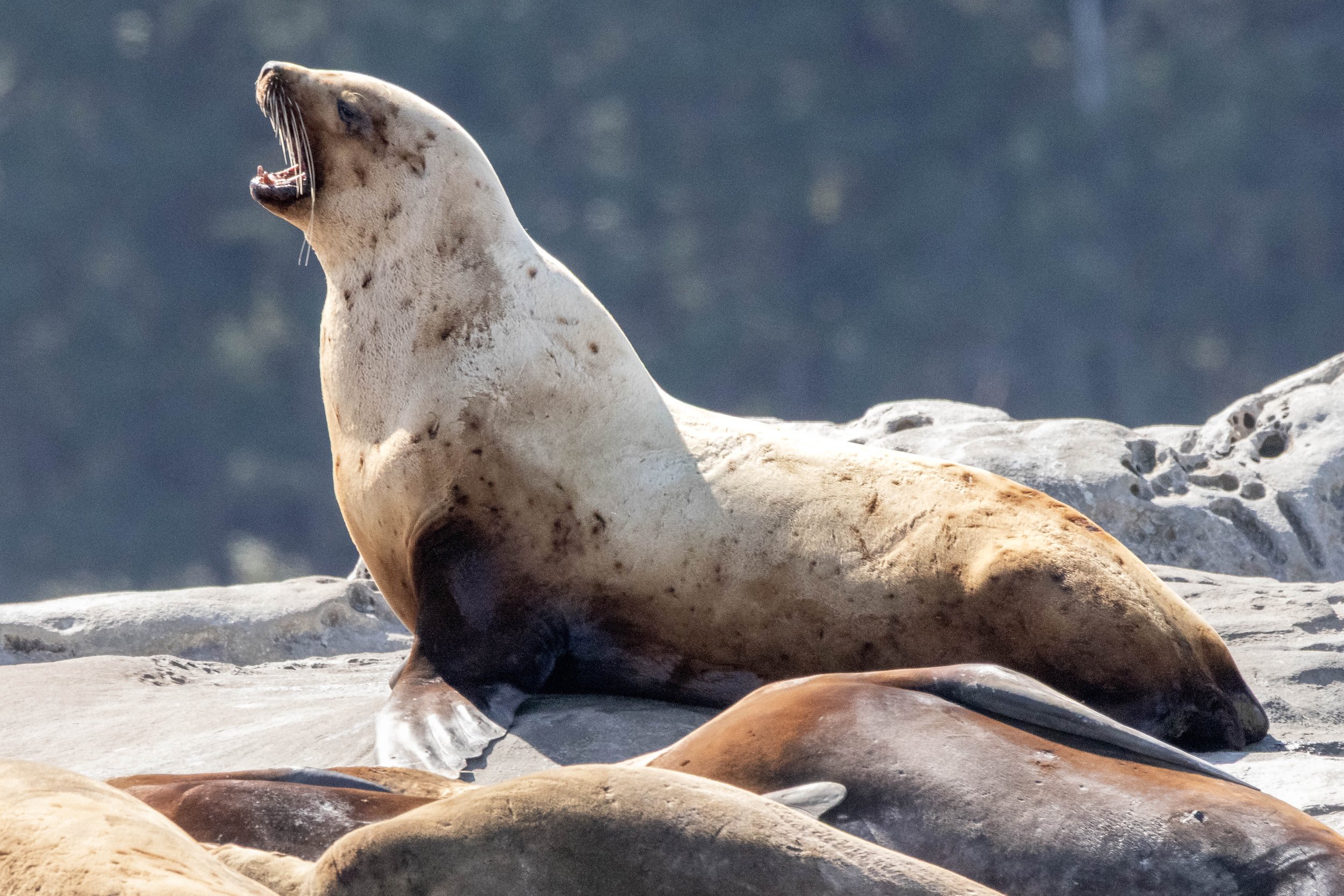April 12, 2025 - Not one, but two different orca encounters!
When you get word of whales near the harbour, it is always extra exciting as we board and depart. Because our whales do not have any trackers or tags on them, we never know how long we will have to search before we locate them. Sometimes they are an hour to an hour and a half away. Not today though - after just 15 minutes on board we spotted several black dorsal fins slicing through the waters near Dodd Narrows! These familiar fins were ID’d as the T049As:
T049A Nan ♀ (1986)
T049A3 Nat ♂ (2011)
T049A4 Neptune ♂ (2014)
T049A5 Nebula ♀ (2017)
T049A6 Charlie II ♂ (2022)
Nan earned her nickname from her frequent sightings in the Nanaimo area. She’s really lived up to that this year, as we have had 8 different encounters with her and her pod in 2025 already! Her youngest calf, T049A6 Charlie II, is a favourite whale for many. Nearly every time he surfaces he brings his face above the water - an unusual trait for an orca. His rostrum (the front part of his head) is flat, which is atypical. Generally, their faces are more pointed and torpedo-shaped to help be as hydrodynamic as possible. Charlie’s blunted rostrum may have occurred from an injury shortly after birth, as he did have a fairly typically-shaped face in our very first encounter with them back in 2022. Whatever the case, we can always find Charlie travelling right alongside his mother Nan!
Nan and her family were travelling down Trincomali Channel, occasionally doing deep dives as they moved along. This is a very typical day for an orca, as they can travel well over 100 km per day if they want to get where they are going! Even when they are just travelling, we love meeting up with our whales and seeing them meandering along side-by-side together, enjoying their family time as they make their way to their next destination!
We departed the T049As and started our search for other wildlife. We popped out into the Strait of Georgia to have a peek at our Steller sea lions and Harbour seals. We have many haulouts, or land areas where our pinnipeds prefer to rest, all along the outside edge of the Southern Gulf Islands. The sun was shining leading to all of them snoozing away, with some of them napping half-submerged!
The fun for the day didn’t end there though, as we caught word of another pod of orca close by. We took off and made our way towards Sansum Narrows, a beautiful waterway in the southern portion of our range. Once we arrived we spotted a trio of fins, two towering over one smaller one, travelling along. These fins were also familiar to us! These three were identified as the T019s:
T019 Nootka ♀ (~1965)
T019B Galiano ♂ (1995)
T019C Spouter ♂ (2001)
The T019s are notoriously efficient at hunting. On several occasions, we have seen them take down prey in as little as 5 minutes. Usually, they pick off Harbour Porpoises - but today, they had a different prey in mind. T019 Nootka suddenly took off and, before we knew it, she had a late lunch ready for herself and her two sons. The prey today was a Harbour Seal. They were so efficient they actually had leftovers at the surface, which is very rare to witness!
GORE WARNING: We will place a warning message for those who may want to view this trip’s photos and not see photos of the aftermath. The aftermath photos will be at the very bottom of this blog.
Once the meal was finished they started to travel along, just like what the T049As were doing earlier. Our orca change their behaviours very fast, so you never know what to expect from trip to trip!
After the thrill of the hunt, it was time for us to conclude the adventure. We left our whales behind and turned northbound, heading back up Stuart Channel and back through Dodd Narrows, wrapping up an amazing day out on the water!
Please enjoy these photos by Marine Naturalist Vanessa Vereschahen!
T049A Nan has a number of unique scratches in her saddlepatch we can use to identify her, plus her dorsal notches.
T049A5 Nebula with her hooked dorsal fin visble.
T049A Nan with the top edge of her eyepatch visible above the surface.
T049A6 Charlie II right behind his mother T049A Nan.
T049A3 Nat beside his (significantly) smaller younger brother T049A4 Neptune.
T049A4 Neptune has a couple small nicks near the bottom of his dorsal which we can use to confirm his ID.
T049A3 Nat travelling along.
T049A6 Charlie II peeking above the water.
T049A Nan with Tree Island in the background.
T019C Spouter with a bunch of water droplets around him.
T019 Nootka beside her eldest son T019B Galiano.
T019B Galiano with his face above the water.
T019B Galiano’s wiggly dorsal fin is very iconic!
T019C Spouter coming nose-to-nose with his older brother T019B Galiano.
T019B Galiano and T019C Spouter - can you ID the two different brothers?
T019 Nootka has a ragged back edge to her dorsal fin.
A Harbour seal snoozing away in the sun.
Harbour seals look very odd when they are half dry and half wet.
A Steller sea lion giving us the stink eye.
Grumbling away on top of the rocks.
A mature Bald Eagle with a fish in its talons.
An immature Loon in flight.
What an impressive wingspan!
A gull soaring by.
GORE WARNING
The photos below include the aftermath of the T019s’ hunt. Viewer discretion is advised.
It is very rare to see the remains after a successful hunt.
This was identified as a Harbour Seal - Harbour Seal intestines are about 16 times the length of their bodies!


























